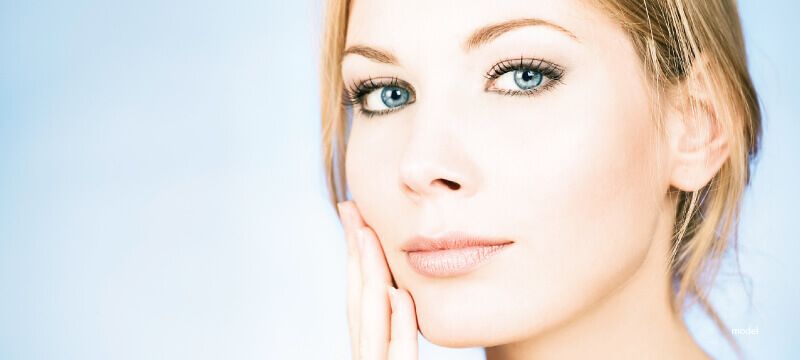Skin Care Ingredient Focus: Benzoyl Peroxide

Benzoyl peroxide has long been a staple among acne-fighting skin care ingredients for one very good reason, it works! It’s a powerful ingredient as it has the power to both clear pores of debris and kill acne causing bacteria like C. acnes.
In this post, we’ll discuss why benzoyl peroxide is such a key ingredient for countering acne as well as the best way to add this pimple fighter to your daily skin care regimen.
About Benzoyl Peroxide
Benzoyl peroxide is a non-specific oxidizing agent. This means when it contacts your skin, it releases oxygen molecules which help treat acne. When it comes to skin care, benzoyl peroxide has three main benefits when it comes to fighting acne: it can be a deep cleanser, an anti-inflammatory skin calmer, or a powerful exfoliant.
Cleansing
Benzoyl peroxide absorbs into pores to clean out dead skin cells, debris, and the excess oils, the buildup of which often results in acne. It also has antibacterial properties, meaning it effectively kills acne-causing bacteria on contact. This makes benzoyl peroxide a great replacement for antibiotics in the fight against pimples. Unlike antibiotics, benzoyl peroxide won’t disrupt your skin’s natural and healthy microbiome.
Anti-Inflammatory Benefits
Benzoyl peroxide also has anti-inflammatory properties. Along with fighting acne it can help minimize redness and reduce the swelling associated with pimples and cystic acne. It’s also a comedolytic, which means it prevents the formation of blemishes due to clogged pores.
Exfoliating
Benzoyl peroxide is a powerful chemical exfoliator which cleanses deeply by removing the skin’s outermost layer. Exfoliating dead skin cells which haven’t yet completely shed keeps skin looking fresher and prevents breakouts.
Treating Acne with Benzoyl Peroxide
Classic Pimples
Thanks to its anti-inflammatory properties, benzoyl peroxide works best on traditional inflamed, red pimples, also known as pustules, cysts, papules, or nodules. It can be used as a daily overall cleanser, but is also the best ingredient for spot-treatment of pimples.
Blackheads & Whiteheads
Blackheads and whiteheads are the result of clogged pores. Benzoyl peroxide treats this type of acne by deeply cleansing and exfoliating the skin. However, because this is not a type of inflammatory acne, other over-the-counter products such as salicylic acid are more often recommended for these types of blemishes.
Cystic Acne
Cystic acne is characterized by hard bumps beneath the skin’s surface without clearly defined ‘heads.’ This type of acne is notoriously difficult to treat, and is caused by bacteria trapped deep underneath the skin’s surface.
Benzoyl peroxide is among the best over the counter treatments for cystic acne. But if you have this type of acne, you may want to discuss prescription-only remedies, such as retinoids, with your healthcare provider.
Benzoyl Peroxide vs Salicylic Acid
Benzoyl peroxide and salicylic acid are both popular acne fighting meditations and each is available over the counter. Both have exfoliating properties and deeply clean the skin, but there are differences too.
Choose Benzoyl Peroxide if…
- You have inflammatory acne
- You’re spot-treating a pimple
- You’re allergic to aspirin (salicylic acid is not recommended for you!)
Choose Salicylic Acid if…
- You’re treating blackheads or whiteheads
- You have dry, sensitive skin
- You’ll be sweating or exercising (benzoyl peroxide can sweat off and bleach your clothes)
If you want to use both products, you may want to avoid using them on the same area of the skin at the same time. To prevent irritation, try alternating days or weeks. Or, use salicylic acid every day, and benzoyl peroxide as a spot-treatment when needed.
Products with Benzoyl Peroxide
- Cleansers and face washes: These products typically have lower concentrations making them ideal for daily use
- Creams and lotions: As acne preventive treatments applied after cleansing
- Body washes and soaps: Ideal for addressing body acne on your back or chest
- Spot treatments and face masks: For leave-on use to treat active breakouts
How to Use Benzoyl Peroxide
As a skin care ingredient, benzoyl peroxide can be found in a variety of concentrations ranging from 2.5 to 10%. However, keep in mind that using a higher concentration isn’t always better. When determining an ideal concentration level it’s important to understand your skin’s sensitivity and how you’ll be using the product.
Rinse-Off Products
Rinse-off products such as cleansers, exfoliants and gels typically contain between 4-10% active ingredient. Because you won’t be leaving the product on your face, it’s safe to go with a stronger concentration.
When introducing a new ingredient to your skin, either start with a lower concentration, or use the product less often. Once you’re certain it’s not too over-drying or irritating, you can increase your usage over time. Start with every other day, then daily.
Leave-On Products
Products designed to stay put throughout the day or overnight typically contain between 2.5-5% active ingredient. This includes spot treatment products, leave-on creams or gels and face masks.
If at any point your skin gets too red, irritated, or dry, back off on your usage. While benzoyl peroxide is great for treating oily skin, stripping the skin of too many oils can increase oil production.
Is Benzoyl Peroxide Safe?
Benzoyl peroxide does have the potential to be over-drying and can cause irritation for those with sensitive skin. If this is you, stick with concentrations below 5% and introduce the product slowly over time. Avoid using benzoyl peroxide if you have a sunburn or a skin condition such as eczema, psoriasis or dermatitis.
In general, benzoyl peroxide is completely safe to use, and has long been a go-to for acne treatment and prevention because of its effectiveness for all skin types.
Disclaimer: The contents of the Westlake Dermatology website, including text, graphics, and images, are for informational purposes only and are not intended to substitute for direct medical advice from your physician or other qualified professional.

Tried a new benzyl peroxide for acne and it worked but really dried out my skin. From reading the post, I may try something with a lower concentration.